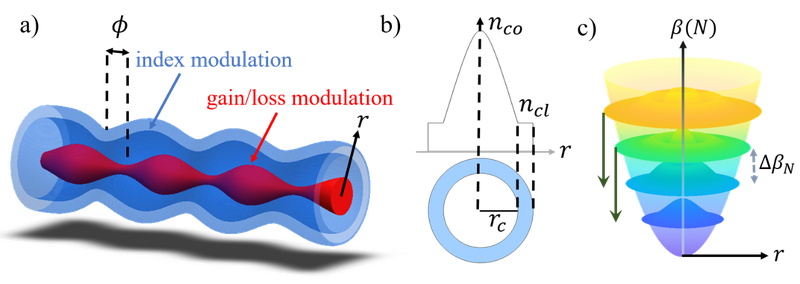Non-Hermitian mode management in optical fibers and waveguides
Dec 23, 2024
Mohammad Nayeem Akhter defended his thesis co-supervised by Kestutis Staliunas and Muriel Botey on December 20, 2024 at Campus Terrassa. Entitled “Non-Hermitian mode management in optical fibers and waveguides", the thesis presents a novel approach to tailoring optical beam transformations in graded index multimode fibers through non-Hermitian mode management
This thesis uncovers a novel approach to tailoring optical beam transformations in GRaded INdex (GRIN) MultiMode Fibers (MMFs) through non-Hermitian mode management. Recently, MMFs have gained a resurgence of interest due to their demand in optical communications, high-power lasers, and dynamic fields of optical sensing and imaging. MMFs exhibit rich and complex spatiotemporal phenomena, and one of their main drawbacks is the poor quality of the propagated beam. Any beam injected in such fibers spontaneously evolves towards a multimode configuration generating speckle formation at the output. This randomness results from the different values of propagation constants of the fiber modes causing random mode phase shifts during propagation. Generally, conventional methods such as modulating the refractive index, dispersion, or nonlinearity along optical fibers, which may induce mode coupling, and parametric or Faraday modulational instability, do not efficiently reduce turbulence, since they generally broaden the angular spectra.
This thesis presents a potentially transformative approach that enables an effective mode-cleaning while reducing turbulence. The proposal is based on the introduction of a periodic non-Hermitian modulation, by simultaneously engineering the refractive index and the gain/loss coefficient along the fibers or waveguides, allowing a precise control the mode coupling. This scheme leads to mode-cleaning in linear and active nonlinear fibers, as a main potential application. Moreover, we also explore the controlled generation of higher-order modes in parabolic GRIN MMF. Importantly, these techniques no longer require high-power or manual adjustment of the input beam. We predict these effects analytically based on either a simplified Gaussian beam model or the standard mode expansion technique. The predictions are then numerically proven by solving the wave propagation equation introducing the longitudinal periodic non-Hermitian potential. The robustness and effectiveness of the proposed scheme have been discussed. We also estimate the conditions and parameters for the experimental realisation of predicted phenomena.

Share: